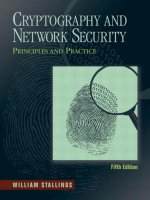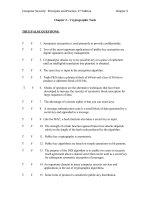Computer security principles and practice 3rd by williams stallings and brown ch03
Bạn đang xem bản rút gọn của tài liệu. Xem và tải ngay bản đầy đủ của tài liệu tại đây (5.62 MB, 44 trang )
Chapter 3
User Authentication
RFC 4949
RFC 4949 defines user authentication as:
“The process of verifying an identity claimed
by or for a system entity.”
Authentication Process
• Fundamental
building block
and primary
line of
defense
• Basis for
access control
and user
accountability
• Identification step
Presenting an
identifier to the
security system
• Verification step
Presenting or
generating
authentication
information that
corroborates the
binding between
the entity and
the identifier
Registration, Credential Issuance,
and Maintenance
Registration
Authority (RA)
Identity Proofing
User Registration
l
tia nce
n
e
ed ssua
r
C /I
n, tion
e
k a
To istr
g
Re
Registration
Confirmation
Credential
Service
Provider (RA)
Subscriber/
Claimant
Authenticated Session
Relying
Party (RP)
Au
th
Authenticated
en
tic
Assertion
Ex at
e
ch d
an Pr
ge oto
co
l
Token/Credential
Validation
Verifier
E-Authentication using
Token and Credential
Figure3.1 TheNIST SP 800-63-2 E-Authentication Architectural Model
The four means of authenticating
user identity are based on:
Something
the
individual
knows
Something
the
individual
possesses
(token)
• Password, PIN,
answers to
• Smartcard,
prearranged
electronic
questions
keycard,
physical key
Something
the
individual is
(static
biometrics)
• Fingerprint,
retina, face
Something
the
individual
does
(dynamic
biometrics)
• Voice pattern,
handwriting,
typing rhythm
Risk Assessment for
User Authentication
• There are
three
separate
concepts:
Assuranc
e Level
Potential
impact
Areas of
risk
Assurance Level
Describes an
organization’s
degree of
certainty that a
user has
presented a
credential that
refers to his or
her identity
More
specifically is
defined as:
The degree of
confidence in the
vetting process used
to establish the
identity of the
individual to whom
the credential was
issued
The degree of
confidence that the
individual who uses
the credential is the
individual to whom
the credential was
issued
Four levels of
assurance
Level 1
• Little or no confidence in
the asserted identity's
validity
Level 2
• Some confidence in the
asserted identity’s validity
Level 3
• High confidence in the
asserted identity's validity
Level 4
• Very high confidence in the
asserted identity’s validity
Potential Impact
• FIPS 199 defines three levels of potential
impact on organizations or individuals
should there be a breach of security:
o Low
• An authentication error could be expected to have a
limited adverse effect on organizational operations,
organizational assets, or individuals
o Moderate
• An authentication error could be expected to have a
serious adverse effect
o High
• An authentication error could be expected to have a
severe or catastrophic adverse effect
Table
3.1
AssuranceLevel Impact Profiles
1
2
3
4
Potential Impact Categories for Authentication Errors
Low
Mod
Mod
High
Inconvenience, distress, or damage to standing or
reputation
Low
Mod
Mod
High
Financial loss or organization liability
None
Low
Mod
High
Harm to organization programs or interests
None
Low
Mod
High
Unauthorized release of sensitive information
Mod/
None
None
Low
Personal safety
High
Civil or criminal violations
None
Low
Mod
High
Maximum Potential Impacts for Each
Assurance Level
Password
Authentication
• Widely used line of defense against
intruders
o User provides name/login and password
o System compares password with the one stored for that
specified login
• The user ID:
o Determines that the user is authorized to access the
system
o Determines the user’s privileges
o Is used in discretionary access control
Password
Vulnerabilities
Offline
dictionary
attack
Password
guessing
against
single user
Specific
account
attack
Popular
password
attack
Workstation
hijacking
Electronic
monitoring
Exploiting
user mistakes
Exploiting
multiple
password
use
Password
Password File
User ID
Salt
slow hash
function
Salt Hash code
•
•
•
Load
(a) Loadinga new password
Password File
User id
User ID
Salt Hash code
Salt
Password
Select
slow hash
function
Hashed password
(b) Verifyinga password
Figure3.2 UNIX Password Scheme
Compare
UNIX Implementation
Original scheme
• Up to eight printable characters in
length
• 12-bit salt used to modify DES
encryption into a one-way hash function
• Zero value repeatedly encrypted 25
times
• Output translated to 11 character
sequence
Now regarded as
inadequate
• Still often required for compatibility with
existing account management software
or multivendor environments
Improved
Implementations
OpenBSD uses Blowfish
block cipher based hash
algorithm called Bcrypt
• Most secure version of Unix
hash/salt scheme
• Uses 128-bit salt to create
192-bit hash value
Much stronger hash/salt
schemes available for
Unix
Recommended hash
function is based on
MD5
• Salt of up to 48-bits
• Password length is unlimited
• Produces 128-bit hash
• Uses an inner loop with 1000
iterations to achieve
slowdown
Password Cracking
Dictionary attacks
• Develop a large
dictionary of possible
passwords and try each
against the password file
• Each password must be
hashed using each salt
value and then
compared to stored hash
values
Password crackers
exploit the fact that
people choose
easily guessable
passwords
• Shorter password
lengths are also easier
to crack
Rainbow table
attacks
• Pre-compute tables of
hash values for all salts
• A mammoth table of
hash values
• Can be countered by
using a sufficiently large
salt value and a
sufficiently large hash
length
John the Ripper
• Open-source password
cracker first developed
in in 1996
• Uses a combination of
brute-force and
dictionary techniques
Modern Approaches
• Complex password policy
o Forcing users to pick stronger passwords
• However password-cracking techniques
have also improved
o The processing capacity available for password cracking has
increased dramatically
o The use of sophisticated algorithms to generate potential
passwords
o Studying examples and structures of actual passwords in use
50%
Percent guessed
40%
30%
20%
10%
0%
104
107
1010
1013
Number of guesses
Figure3.3 ThePercentageof Passwords Guessed After
a Given Number of Guesses
Password File Access
Control
Can block offline guessing attacks by
denying access to encrypted passwords
Make
available
only to
privileged
users
Shadow
password
file
Vulnerabilities
Weakness
in the OS
that
allows
access to
the file
Accident
with
permissio
ns making
it
readable
Users
with same
password
on other
systems
Access
from
backup
media
Sniff
password
s in
network
traffic
Password Selection Strategies
User education
Users can be told the importance of using hard to guess passwords and can be provided with guidelines for
selecting strong passwords
Users have trouble remembering them
Computer
generated passwords
Reactive password checking
System periodically runs its own password cracker to find guessable passwords
Complex password policy
User is allowed to select their own password, however
the system checks to see if the password is allowable,
and if not, rejects it
Goal is to eliminate guessable passwords while allowing
the user to select a password that is memorable
Proactive Password
Checking
Password cracker
Rule enforcement
•• Specific
Specific rules
rules that
that
•• Compile
passwords
passwords must
must adhere
adhere to
to
Compile a
a large
large
dictionary
dictionary of
of passwords
passwords
not
not to
to use
use
Bloom filter
•• Used
Used to
to build
build a
a table
table based
based
on
on dictionary
dictionary using
using hashes
hashes
•• Check
Check desired
desired password
password
against
against this
this table
table
1
0 .1
Pr[false positive]
2 h a s h fu n c tio n s
0 .0 1
4 h a s h fu n c tio n s
6 h a s h fu n c tio n s
0 .0 0 1
0
5
10
15
R a tio o f h a s h ta b le s iz e (b its ) to d ic tio n a ry s iz e (w o rd s )
F i g u r e 3 .4 P e r f o r m a n c e o f B l o o m F i l t e r
20
Table 3.2
Card Type
Embossed
DefiningFeature
Raised characters only, on
front
Example
Old credit card
Magnetic stripe
Magnetic bar on back, characters on front
Bank card
Memory
Electronic memory inside
Prepaid phone card
Smart
Contact
Contactless
Electronic memory and processor inside
Electrical contacts exposed on surface
Radio antenna embedded inside
Biometric ID card
Types of Cards Used as Tokens
Memory Cards
•
•
•
•
Can store but do not process data
The most common is the magnetic stripe card
Can include an internal electronic memory
Can be used alone for physical access
o Hotel room
o ATM
• Provides significantly greater security when combined
with a password or PIN
• Drawbacks of memory cards include:
o Requires a special reader
o Loss of token
o User dissatisfaction
Smart Tokens
•
Physical characteristics:
•
Interface:
o Include an embedded microprocessor
o A smart token that looks like a bank card
o Can look like calculators, keys, small portable objects
o Manual interfaces include a keypad and display for interaction
o Electronic interfaces communicate with a compatible
reader/writer
•
Authentication protocol:
o Classified into three categories:
• Static
• Dynamic password generator
• Challenge-response









